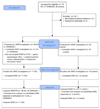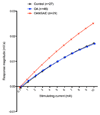Electrophysiological characterisation of central sensitisation in canine spontaneous osteoarthritis
- PMID: 29994993
- PMCID: PMC6195806
- DOI: 10.1097/j.pain.0000000000001336
Electrophysiological characterisation of central sensitisation in canine spontaneous osteoarthritis
Abstract
In man, central sensitisation (CS) contributes to the pain of osteoarthritis (OA). Dogs with spontaneous OA may also exhibit CS. Electrophysiological reflex measurements are more objective than behavioural assessments and can be used to evaluate CS in preclinical and clinical studies. It was hypothesised that dogs suffering from OA would exhibit electrophysiological characteristics indicative of CS, associated with reduced diffuse noxious inhibitory controls (DNICs). One hundred and seventeen client-owned dogs were recruited to the study. Hind limb nociceptive withdrawal reflex thresholds, stimulus response, and temporal summation characteristics were recorded, during alfaxalone anaesthesia, from 46 OA dogs, 29 OA dogs receiving nonsteroidal anti-inflammatory drugs (OANSAIDs), and 27 breed- and weight-matched control dogs. Efficacy of DNIC was evaluated in 12 control and 11 of the OA dogs, by application of a mechanical conditioning stimulus to the contralateral forelimb. Nociceptive withdrawal reflex thresholds were higher in OA compared with control dogs (P = 0.02). Stimulus response characteristics demonstrated an augmented response in OANSAID dogs compared with OA (P < 0.001) and control (P < 0.001) dogs. Temporal summation demonstrated exaggerated C-fibre-mediated responses in both OA (P < 0.001) and OANSAID (P = 0.005) groups, compared with control animals. Conditioning stimulus application resulted in inhibition of test reflex responses in both OA and control animals (P < 0.001); control animals demonstrated greater inhibition compared with OA (P = 0.0499). These data provide evidence of neurophysiological changes consistent with CS in dogs with spontaneous OA and demonstrate that canine OA is associated with reduced DNIC.
Conflict of interest statement
The authors declare no conflict of interest.
Figures







Similar articles
-
Alfaxalone Anaesthesia Facilitates Electrophysiological Recordings of Nociceptive Withdrawal Reflexes in Dogs (Canis familiaris).PLoS One. 2016 Jul 19;11(7):e0158990. doi: 10.1371/journal.pone.0158990. eCollection 2016. PLoS One. 2016. PMID: 27433936 Free PMC article.
-
Widespread somatosensory sensitivity in naturally occurring canine model of osteoarthritis.Pain. 2016 Jun;157(6):1325-1332. doi: 10.1097/j.pain.0000000000000521. Pain. 2016. PMID: 26901805 Free PMC article.
-
An investigation of mechanical nociceptive thresholds in dogs with hind limb joint pain compared to healthy control dogs.Vet J. 2018 Apr;234:85-90. doi: 10.1016/j.tvjl.2017.12.012. Epub 2017 Dec 15. Vet J. 2018. PMID: 29680400
-
Nonsteroidal anti-inflammatory drugs and corticosteroids for the management of canine osteoarthritis.Vet Clin North Am Small Anim Pract. 1997 Jul;27(4):841-62. doi: 10.1016/s0195-5616(97)50083-0. Vet Clin North Am Small Anim Pract. 1997. PMID: 9243784 Review.
-
Quantitative sensory testing in feline osteoarthritic pain - a systematic review and meta-analysis.Osteoarthritis Cartilage. 2020 Jul;28(7):885-896. doi: 10.1016/j.joca.2020.04.006. Epub 2020 Apr 29. Osteoarthritis Cartilage. 2020. PMID: 32360738
Cited by
-
COAST Development Group's international consensus guidelines for the treatment of canine osteoarthritis.Front Vet Sci. 2023 Aug 3;10:1137888. doi: 10.3389/fvets.2023.1137888. eCollection 2023. Front Vet Sci. 2023. PMID: 37601753 Free PMC article. Review.
-
Pressure pain mapping of equine distal joints: feasibility and reliability.Front Pain Res (Lausanne). 2024 Apr 25;5:1342954. doi: 10.3389/fpain.2024.1342954. eCollection 2024. Front Pain Res (Lausanne). 2024. PMID: 38726353 Free PMC article.
-
Three-dimensional kinematic evaluation of lateral suture stabilization in an in vitro canine cranial cruciate deficient stifle model.PLoS One. 2021 Dec 20;16(12):e0261187. doi: 10.1371/journal.pone.0261187. eCollection 2021. PLoS One. 2021. PMID: 34928969 Free PMC article.
-
The beneficial role of companion animals in translational pain research.Front Pain Res (Lausanne). 2022 Sep 5;3:1002204. doi: 10.3389/fpain.2022.1002204. eCollection 2022. Front Pain Res (Lausanne). 2022. PMID: 36133153 Free PMC article. Review.
-
Pain burden, sensory profile and inflammatory cytokines of dogs with naturally-occurring neuropathic pain treated with gabapentin alone or with meloxicam.PLoS One. 2020 Nov 30;15(11):e0237121. doi: 10.1371/journal.pone.0237121. eCollection 2020. PLoS One. 2020. PMID: 33253197 Free PMC article.
References
-
- Arendt-Nielsen L, Egsgaard LL, Petersen KK. Evidence for a central mode of action for etoricoxib (COX-2 inhibitor) in patients with painful knee osteoarthritis. Pain. 2016;157:1634–1644. - PubMed
-
- Arendt-Nielsen L, Nie H, Laursen MB, Laursen BS, Madeleine P, Simonsen OH, Graven-Nielsen T. Sensitization in patients with painful knee osteoarthritis. Pain. 2010;149:573–581. - PubMed
-
- Bannister K, Patel R, Goncalves L, Townson L, Dickenson AH. Diffuse noxious inhibitory controls and nerve injury: restoring an imbalance between descending monoamine inhibitions and facilitations. Pain. 2015;156:1803–1811. - PubMed
-
- Barnhart MD, Hubbell JAE, Muir WW. Evaluation of the analgesic properties of acepromazine maleate, oxymorphone, medetomidine and a combination of acepromazine-oxymorphone. Vet Anaes Analg. 2000;27:89–96. - PubMed
-
- Bars DL, Dickenson AH, Besson J-M. Diffuse noxious inhibitory controls (DNIC). II. Lack of effect on non-convergent neurones, supraspinal involvement and theoretical implications. Pain. 1979;6:305–327. - PubMed
MeSH terms
Substances
Grants and funding
LinkOut - more resources
Full Text Sources
Other Literature Sources
Medical

